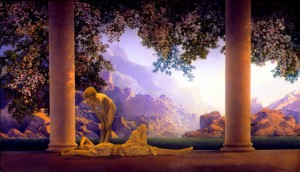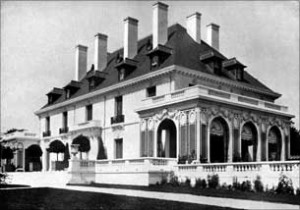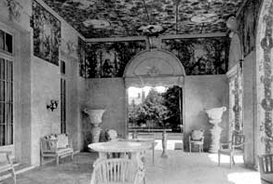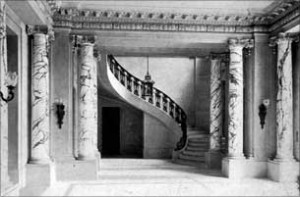“Daybreak” by Maxfield Parrish, 1922
The National Museum of American Illustration in Newport Rhode Island houses one of the largest collections of work by Artist Maxfield Parrish. As well as works by Norman Rockwell, Howard Pyle, J. C. Leyendecker & N. C. Wyeth. All set within the impressive Architecture of the Gilded Age. The National Museum of American Illustration (NMAI) was founded in 1998 by Judy Goffman Cutler and Laurence S. Cutler to house their art collection primarily from the ‘Golden Age of American Illustration,’ yet the museum exhibits American illustration from all periods, styles and talents. The Museum venue is Vernon Court (1898), an interpretation of an 18th century French chateau from the ‘Gilded Age of Architecture,’ designed by Carrére & Hastings. Vernon Court, an adaptation of an early 18th century French chateau, was designed and built in 1898 for Mrs. Richard van Nest Gambrill of Peapack, New Jersey. Occupying one full block on Newport’s historic Bellevue Avenue, Vernon Court was widely heralded as one of the most spectacular mansions of its kind in America.
Maxfield Parrish: As children, none of us can forget the first instance of seeing an art print or a book illustrated by Maxfield Parrish. (Mine was at a childhood friend’s house and I visited the bathroom every chance I got to look and dream along with Parrish’s images hanging there! He’s been a favorite ever since.) Everyone recognizes the magical world woven by Parrish, usually with the color lapiz lazuli in its purest form. His signature use of this color was so powerful that a certain cobalt blue became known as ‘Parrish Blue’.
His idealized images with figures of feminine pulchritude adorned in classical gowns with backgrounds of electric violets, radiant reds and rich glowing earth tone pigments, created an idyllic world indeed. Other images had scenes embellished with billowing clouds in a fairy tale ambience of maidens and knights lying under porticoes and these were equally harmonic, idealistic, and beloved. Books illustrated by Parrish no longer belonged to their authors, but rather they became ‘Parrish’ books, just as a generic color became ‘Parrish Blue.’ As a result of this ability to create such a sublime splendor, Maxfield Parrish became unquestionably the most successful and best-known American illustrator of the early part of the twentieth century. It’s hard not to beleive that his paintings were of real places and that these extraordinary people and fire-breathing dragons actually lived and coexisted peacefully. Their images were too realistic not to be believed. Their stark beauty and superb execution denied us any ability to question their existence. They were photographic, mechanical and above all, technically accurate.
For 58 years he was married to Lydia, an art instructor who later became one of the first documentors of African-American slave songs of the Deep South. Yet, he also had a beautiful model/mistress and one of the most romantic relationships of the century. For over 55 years, the lovely Susan Lewin was his constant companion.
In 1960, a few years after the death of Lydia, when he did not marry Susan, she retaliated by marrying a childhood friend. Although 90 years old, Parrish was still painting actively, but upon learning of Susan’s marriage, he never painted again.
His life was rich and full and he did not suffer as many other artists have with tortured lives. In fact, he was a Hollywood-handsome man who had stashed his incredible talented self away in the remote hills of New Hampshire and once there, created a make-believe world of his own and never left.
However, the fact remains that very few of Parrish’s original paintings have been seen by contemporary art audiences. The most recent major exhibitions of his work were held in 1961 at a Bennington College exhibit, then in 1964 at the Gallery of Modern Art in New York, again in 1974 at the Brandywine River Museum in a tribute exhibition entitled “Master of Make Believe.” The most recent comprehensive exhibition was in 1989 at the American Illustrators Gallery, the first New York exhibition since his death at the ripe and enviable old age of 95.
After a long and self-satisfied life, this striking and earnest gentleman died on March 30, 1966, at his home and studio, ‘The Oaks’ in Plainfield, New Hampshire. His artistic career had ended some six years earlier.
About the painting featured above:
Daybreak is a painting by Maxfield Parrish (1870–1966) made in 1922. Daybreak is regarded as the most popular art print of the 20th century, based on number of prints made: one for every four American homes. According to the The National Museum of American Illustration, it has outsold Andy Warhol’s Campbell’s Soup Cans and Da Vinci’s Last Supper. It is still in print.
Parrish referred to Daybreak as his “great painting”, the epitome of his work. Measuring 26.5 by 45 inches (67.3 × 114 cm), the painting employs a formal layout similar to a stage set, with two feminine figures. Painted using preparatory photographs, the models were his regular models, Kitty Owen (granddaughter of William Jennings Bryan), Parrish’s daughter Jean, and Susan Lewin. Only two figures appear in the completed painting, though pencil studies indicate that the artist originally intended a third near the righthand column.
An amazing tribute to American Illustrators set in and equally amazing structure. My only complaint, where to look?!
The National Museum of American Illustration
Vernon Court
492 Bellevue Avenue
Newport, Rhode Island 02840




